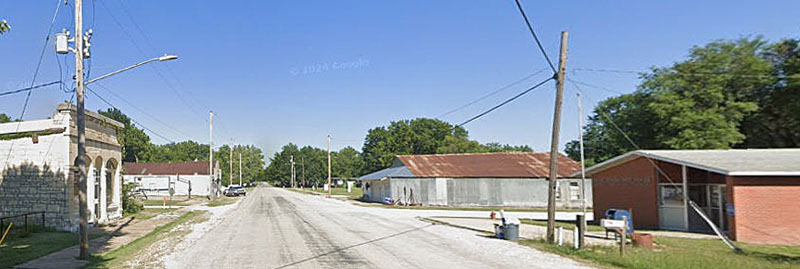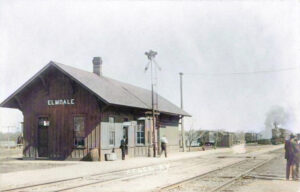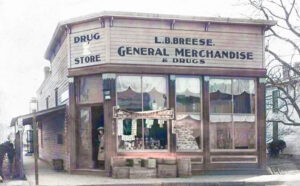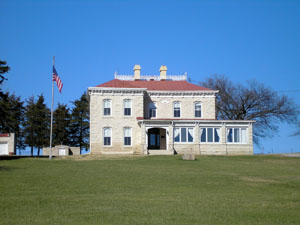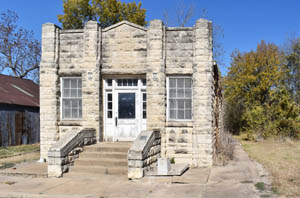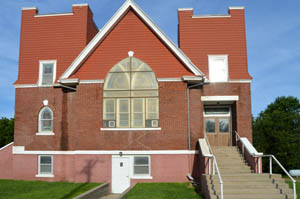Elmdale, Kansas, is a tiny semi-ghost town on the Cottonwood River in Diamond Creek Township of Chase County. As of the 2020 census, its population was 40, and its total area was 0.17 square miles, all of it land.
In 1871, the Atchison, Topeka & Santa Fe Railroad built a main line east-west through Elmdale.
On January 7, 1873, a post office was relocated from Middle Creek (an extinct town) to the rail community of Elmdale.
In 1878, Elmdale had three churches — Congregational and Methodist North and South, a common school, two boarding houses, two general stores, a druggist, a physician, a blacksmith, a wagonmaker, a hardware store, the Osage flour mills, telegraph and express offices, a bank, and a population of 100. It exported grain and livestock and was on the stagecoach line to Junction City and Skiddy. Its mail was delivered daily to P.C. Jeffrey, the postmaster.
In 1885, it had Methodist Episcopal and Christian churches, a district school, two boarding houses, a bank, two general stores, a blacksmith, a wagonmaker, a physician, a hardware store, a furniture store, a saw and flour mill, and a population of 300.
The Chase County Poor Farm was located a mile south of Elmdale and east of the railroad. Its 160 acres straddled the Cottonwood River, which cut a path along the hills to the east. A clipping from the Chase County Leader on Oct 12, 1915, reported three horses, three cows, and six hogs. The number of “inmates” was six.
In 1901, the Independent Telephone Company completed a line from Emporia to Cottonwood Falls. It connected with Bazaar, Matfield Green, Elmdale, Hymes, Safford, Toledo, and several large ranches.
Elmdale was incorporated in 1904.
In 1909, a Kansas gas and cement company representative brought in a report of the largest gas wells found in this territory. They were both on the poor farm. Two wells on the poor farm flowed 2,000,000 and 2,500,000 feet each 24 hours. These two wells coupled onto the pipeline provided pressure at Emporia of about 200 pounds to the inch without the help of the pump station when only about 50 pounds was enough to supply all the demand.
In 1910, Elmdale was still a station on the Atchison, Topeka & Santa Fe Railroad with telegraph and express offices, a money order post office with two rural routes, all the main lines of merchandising, a bank, and a weekly newspaper called the Elmdale Gas Jet. Its population peaked that year at 253. By that time, natural gas had been discovered in the vicinity.
In 1916, Camp Wood YMCA was built about 1.5 miles south of Elmdale. Still open today, Camp Wood offers a safe place for youth, adults, and families to get away from everyday living and enjoy the natural surroundings. The professional and caring staff provide a family atmosphere for first-time and experienced campers. The camp offers a summer resident camp and facilities for retreats and conferences, outdoor education and teambuilding, and family getaways and reunions. Flint Hills native stone cabins are available.
The People’s Exchange Bank was chartered in 1891 and opened in a frame building. In 1898, the bank moved into a limestone building on Main Street. The bank did not close during the Great Depression.
Numerous floods occurred during Elmdale’s history. Due to heavy rains in June and July 1951, rivers and streams flooded many cities in Kansas, including Elmdale. Many reservoirs and levees were built in Kansas in response to the Great Flood of 1951. A levy was built and saved the town from several other floods, but in 1998, a flood went over the levy.
The Elmdale Cougars won the Kansas State High School class B baseball championship in 1961.
In 1967, the high school closed, and the grade school later closed.
The Clover Cliff Ranch House, four miles southwest of Elmdale, was listed on the National Register of Historic Places in November 1977. This stock ranch was established in about 1854 at the mouth of Diamond Spring Creek. Seth Hays kept it as a branch of his trading post at Council Grove. Today, it serves as a Bed & Breakfast Inn.
The McNee Barns, located on U.S. Route 50, three miles southwest of Elmdale, were added to the National Register of Historic Places in June 2013. The site includes a horse barn built circa 1920, a boxcar barn built circa 1948, a stone fence, and an Aermotor windmill.
Today, Chase County’s USD 284 public school district serves the community. It has two schools: the Chase County Junior/Senior High School, located at 600 Main Street in Cottonwood Falls, and the Chase County Elementary School, located at 410 Palmer Street in Strong City.
Elmdale is located along U.S. Route 50 highway, six miles west of Cottonwood Falls, the county seat.
©Kathy Alexander/Legends of Kansas, November 2024.
Also See:
One-Room, Country, & Historic Schools of Chase County
Sources:
1884-1885 Gazetteer and Business Directory, R.L. Polk and Co.
Abandoned Kansas
Blackmar, Frank W.; Kansas: A Cyclopedia of State History, Vol I; Standard Publishing Company, Chicago, IL 1912.
Bronson Pilot, September 11, 1909
Kansas Historic Resources Inventory
Polk’s 1878 Gazetteer and Business Directory
Wikipedia

